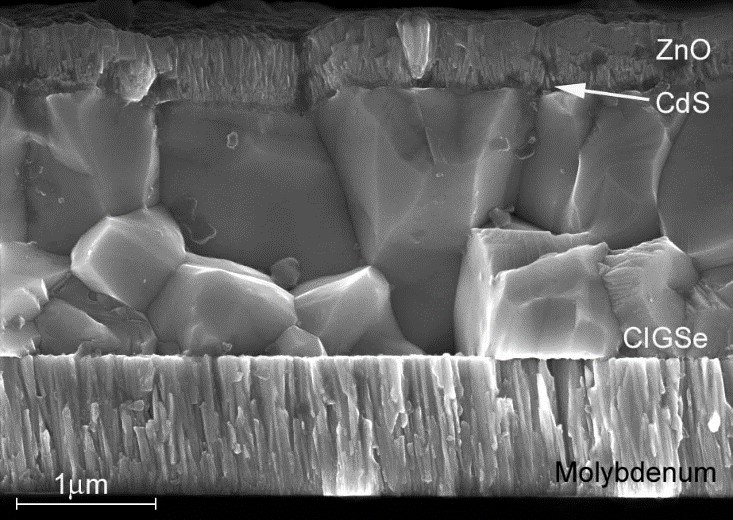PVcomB
Surface and interface analysis of thin film solar cell components
In compound thin film solar cells like those based on chalcopyrites, interfaces between the different layers that constitute the device (Fig.1) are crucial for the solar cell performance. Interfaces between p-type CIGSe-absorber and n-type CdS-buffer layer lead to the formation of the charge-separating built-in voltage and their quality is directly linked to the efficiency of the device. Furthermore, interfaces exist between buffer and window layer and at the back contact between the molybdenum and the absorber. The complexity increases with tandem solar cells which have even more interfaces. These too can have an impact on the quality of the entire device. Understanding these interfaces in terms of electronic and chemical properties is therefore necessary to further improve existing and to develop new device concepts.
In order to examine surfaces of the individual layers, surface sensitive x-ray and ultraviolet photo electron spectroscopy (XPS, UPS) are utilized at PVcomB, either using an in-house laboratory-based system "CISSY" or dedicated end-stations at the BESSY II storage ring.
Expertise and facilities of the CIGS analytics group are also used to provide assistance to groups working on other materials and devices.
Recent topics
Development of hole conducting materials for recombination junctions in thin film tandem devices
2-terminal photovoltaic tandem devices require a so-called recombination junction between top and bottom cell in order to allow current flow through the device. This recombination junction consists of a double layer of highly n and p-doped materials, i.e., n-doped ZnO and p-doped NiOx in the case of lead-halide perovskite/chalcopyrite thin film tandem devices.
We develop sputter-deposited NiOx as hole conductor, using the sputter chamber of the CISSY cluster tool. We use rf sputtering from ceramic targets to produce thin layers of NiOx or Cu-doped NiOx directly onto the ZnO front contact of chalcopyrite bottom devices. In-system XPS and UPS are then used to characterize the freshly deposited layers without intermediate contact to ambient air. XPS is used to determine the surface composition, namely the ratio between Ni2+ and Ni3+and the presence of any contamination, while UPS is used to measure valence band position and work function of the deposited materials.
References
Ivona Kafedjiska, Igal Levine, Artem Musiienko, Natalia Maticiuc, Tobias Bertram, Amran Al-Ashouri, Christian A. Kaufmann, Steve Albrecht, Rutger Schlatmann, and Iver Lauermann, Advanced Characterization and Optimization of NiOx:Cu-SAM Hole-Transporting Bi-Layer for 23.4% Efficient Monolithic Cu(In,Ga)Se2-Perovskite Tandem Solar Cells, Adv. Funct. Mater. 2023, 2302924, DOI: 10.1002/adfm.202302924
Surface analysis of catalytic layers
Cerium-based catalysts
XPS is used to examine the composition of cerium-based catalysts before and after their use in real working environments. Here, especially the ratio between Ce3+ and Ce4+ is important for the understanding of the catalytic activity. Another question pertains to the phosphorus content in phosphorus-doped CeO₂ thin films.
ZnO/Cu catalytic thin layers
Another catalytic material system examined with XPS is a patterned ZnO/Cu layer stack used for CO2 reduction. Here the ratio of Cu to ZnO before and after catalytic reactions and after annealing of pristine layer stacks is examined.
Porous nickel oxide layers
Thin layers of NiOx and Cu: NiOx are sputter-deposited on Ni-felt substrates and analyzed in-system by XPS. These materials are used as catalysts for the alkaline oxygen evolution.
Analysis of degradation of hydrogen-terminated silicon surfaces
XSP is used to examine the surface oxidation of passivated silicon surfaces after exposure to dry and humid air, respectively.
References
Karuppasamy Dharmaraj; Rania Hanna; Iver Lauermann; Rory Bagacki; Fanxing Xi; Erno Kemppainen; Rutger Schlatmann; Sonya Calnan, Electrodeposited porous nickel-copper as non-noble metal catalyst for urea assisted anion exchange membrane electrolysis for hydrogen production, ACS SUSTAINABLE CHEMISTRY & ENGINEERING 12 (26), (2024) pp.9908-9921, doi: https://doi.org/10.1021/acssuschemeng.4c02424

